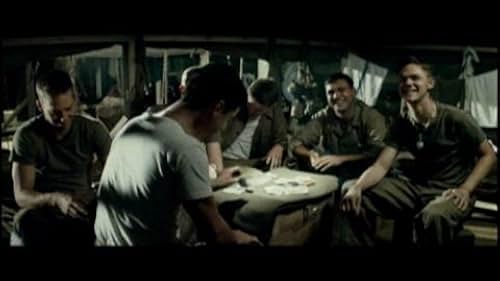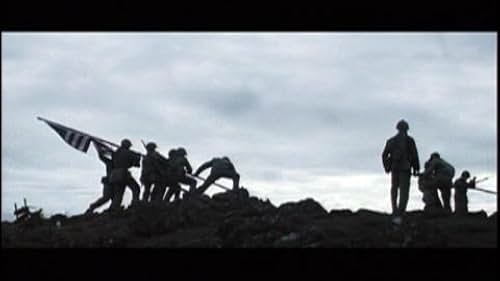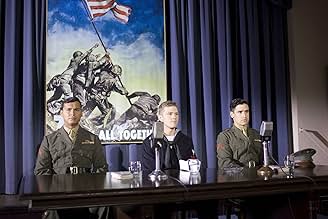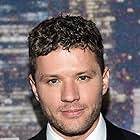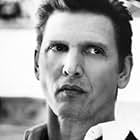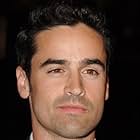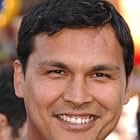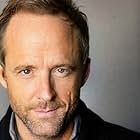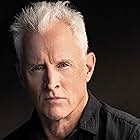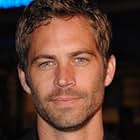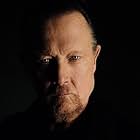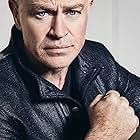Le storie di vita dei sei uomini che hanno alzato la bandiera nella battaglia di Iwo Jima, un punto cardine della seconda guerra mondiale.Le storie di vita dei sei uomini che hanno alzato la bandiera nella battaglia di Iwo Jima, un punto cardine della seconda guerra mondiale.Le storie di vita dei sei uomini che hanno alzato la bandiera nella battaglia di Iwo Jima, un punto cardine della seconda guerra mondiale.
- Candidato a 2 Oscar
- 16 vittorie e 28 candidature totali
Trama
Lo sapevi?
- QuizThe story about the flag raising being posed was true. It was started, ironically, by Joe Rosenthal. He did not know he had taken the famous photograph until he returned to the States. He did, however, take a second photograph of the five Marines and one Navy Corpsman gathered around the flag. When people asked if he had posed the photograph, he, thinking they were referring to the second photograph said "Of course". It was only after seeing the first photograph that he realized they were referring to that photograph and not the second one.
- BlooperIn explaining the importance of a successful bond drive, the treasury representative says that the fuel dumps are empty and "our Arab friends only take bullion." At the time of World War II, America was essentially self sufficient in oil production and not dependent on Arab oil. While oil was discovered in some Arab countries before the war, it was not extensively developed until after the war.
- Citazioni
[last lines]
James Bradley: I finally came to the conclusion that he maybe he was right. Maybe there's no such thing as heroes. Maybe there are just people like my dad. I finally came to understand why they were so uncomfortable being called heroes. Heroes are something we create, something we need. It's a way for us to understand what's almost incomprehensible, how people could sacrifice so much for us, but for my dad and these men, the risks they took, the wounds they suffered, they did that for their buddies. They may have fought for their country but they died for their friends. For the man in front, for the man beside him, and if we wish to truly honor these men we should remember them the way they really were, the way my dad remembered them.
- Curiosità sui creditiThere is an additional short sequence after the credits have ended.
- Colonne sonoreKnock Knock
Written and Performed by Kyle Eastwood, Michael Stevens, Andrew McCormack and Graeme Flowers
That one picture is said to be the most reproduced picture in the history of photography.
I toured Iwo Jima in 2000 with my father, a private in the 5th Marine Division, who, along with the flag raisers, landed on Iwo Jima on February 19, 1945 -- the opening day of what would be the costliest battle in the history of the U.S. Marine Corps.
I can't say enough good things about the realism of Clint Eastwood's "Flags of our Fathers." Visually, the movie made me think that I was back on Iwo Jima, and emotionally, I felt like I was witnessing what I had been told by Iwo survivors and what I had read in Richard E. Overton's "God Isn't Here: A Young American's Entry into World War II and His Participation in the Battle for Iwo Jima."
James Bradley's book "Flags of our Fathers," is wonderful, and this movie of the same name is very faithful to his book.
But, the editing of the movie takes the viewer through so many flash-backs and flash-forwards that it's hard to keep things straight -- even if you have read the book!
The movie opens with Harve Presnel (I think it was Harve) playing the role of what I thought was a narrator. Later, it looks like he's just one of many people that James Bradley interviewed for his book.
I was expecting some corny things in the movie, like seeing the flag raising picture taking up the full screen in the theater while the Marine Corps Hymn played. That didn't happen. After I heard what I thought was a narrator, I thought that anyone who didn't know what was going on in the movie would probably be kept informed of the not-so-obvious things . . . like it was Howlin' Mad Smith who was demanding, and not getting, additional bombardment of the island; like it was Secretary of the Navy, James Forrestal, who told Howlin' Mad Smith that "...the raising of that flag on Suribachi means a Marine Corps for the next five hundred years." These events were in the movie, but the characters were neither introduced by name in the movie, nor were they described by "the narrator," who seemed to come and go at odd times.
Ira Hayes is a tragic character. It's obvious that Hollywood likes tragic characters just because of all of the attention that he gets in this movie, and because Tony Curtis made a movie about Ira Hayes back in 1961. The actor who plays Ira in this movie is great!
Stephen Spielberg and Clint Eastwood obviously had to tap dance around an "Elephant in the Room" when it came to showing what happened to John Bradley's friend on Iwo Jima. If you've read the book, you know what happened. The movie does a masterful job of bringing the subject up, but not bringing it up in a manner that would offend the squeamish, or, for that matter, bringing it up in a way that would make it impossible to show the movie to a Japanese audience.
I più visti
Dettagli
- Data di uscita
- Paese di origine
- Siti ufficiali
- Lingua
- Celebre anche come
- Ngọn Cờ Cha Ông
- Luoghi delle riprese
- Aziende produttrici
- Vedi altri crediti dell’azienda su IMDbPro
Botteghino
- Budget
- 90.000.000 USD (previsto)
- Lordo Stati Uniti e Canada
- 33.602.376 USD
- Fine settimana di apertura Stati Uniti e Canada
- 10.245.190 USD
- 22 ott 2006
- Lordo in tutto il mondo
- 65.900.249 USD
- Tempo di esecuzione2 ore 15 minuti
- Colore
- Mix di suoni
- Proporzioni
- 2.39 : 1
Contribuisci a questa pagina



